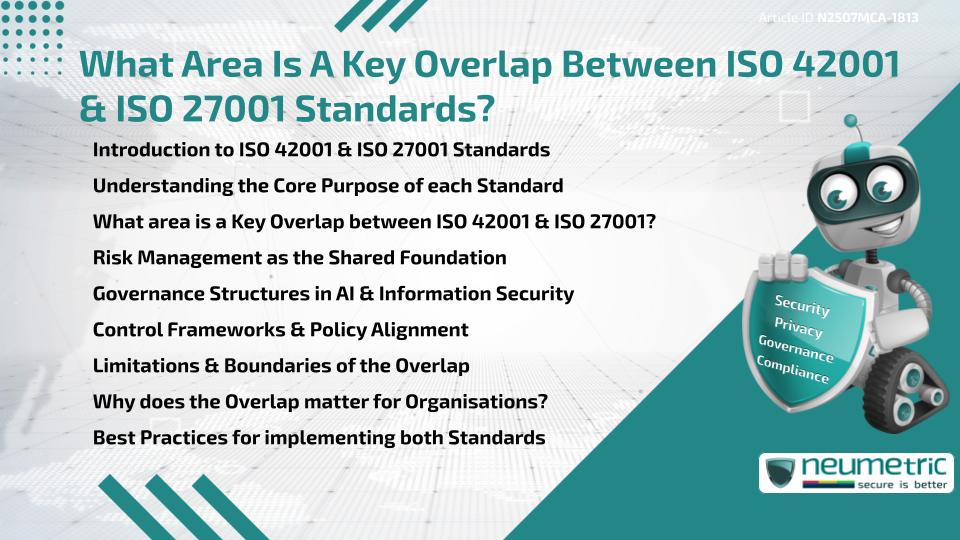Table of Contents
ToggleIntroduction to ISO 42001 & ISO 27001 Standards
As businesses expand their reliance on Artificial Intelligence [AI] & digital ecosystems, the demand for comprehensive standards has surged. ISO 27001, a globally recognised Standard for Information Security & ISO 42001, the newly established Framework for AI Management, represent two pillars in organisational Governance. But what area is a key overlap between ISO 42001 and ISO 27001?
Both standards were developed by the International Organisation For Standardisation [ISO] to guide Organisations in building structured, secure & ethically managed systems. While their scopes are distinct—Information Security versus AI Lifecycle Governance—they share common principles. One area of significant overlap is Risk Management, which forms the heart of both frameworks.
Understanding the Core Purpose of each Standard
ISO 27001 is focused on building an Information Security Management System [ISMS]. It aims to ensure that Sensitive Data is protected from unauthorised access, breaches & operational disruptions.
ISO 42001, on the other hand, introduces an Artificial Intelligence Management System [AIMS]. Its primary focus is to ensure AI Systems are reliable, ethical & governed responsibly throughout their lifecycle—from development to deployment.
Despite these unique objectives, they intersect at the point where data, ethics & operational Risks converge.
What area is a Key Overlap between ISO 42001 and ISO 27001?
The central question—what area is a key overlap between ISO 42001 and ISO 27001—is best answered by examining their mutual emphasis on Risk Management.
Risk Management acts as a common language between the two standards. In ISO 27001, Organisations identify & mitigate Risks to their data & IT infrastructure. Similarly, ISO 42001 expects enterprises to address Risks related to AI bias, Transparency & Accountability. Both rely on proactive assessments to prevent harms before they materialise.
This shared focus not only improves Compliance efficiency but also helps Organisations achieve better control & resilience across their digital & AI environments.
Risk Management as the Shared Foundation
Risk Management in ISO 27001 is driven by controls & continual improvement. It requires the evaluation of potential risks to the confidentiality, integrity & availability of information.
In ISO 42001, the focus of risk assessment expands to address the effects of algorithms, unintended behaviours of AI & ethical considerations. However, the process structure—identifying, evaluating & mitigating Risks—is highly similar.
This alignment allows Organisations to harmonise efforts & leverage one system to support both standards. For example, a single enterprise-wide Risk register could serve dual Compliance efforts.
Governance Structures in AI & Information Security
Another strong connection when exploring what area is a key overlap between ISO 42001 and ISO 27001 is the emphasis on Governance. Both standards stress the importance of leadership, accountability & internal policy structures.
ISO 27001 requires clearly defined roles for managing Information Security. ISO 42001 mirrors this by establishing responsibility for AI oversight, ensuring those deploying AI understand & manage its outcomes.
Good Governance ensures that Risk is not an afterthought. Instead, it is embedded in the culture & processes of an Organisation—whether it relates to Cybersecurity or Algorithmic Integrity.
Control Frameworks & Policy Alignment
Control selection is a vital process in both standards. ISO 27001 includes a catalogue of controls under Annex A. ISO 42001 builds on this by incorporating AI-specific controls, such as transparency obligations & bias prevention.
Organisations seeking to align with both standards should integrate their control mapping processes. Unified policy management avoids duplication & simplifies audits.
See NIST’s AI RMF for examples of how AI controls can be structured in alignment with traditional Cybersecurity practices.
Limitations & Boundaries of the Overlap
While asking what area is a key overlap between ISO 42001 and ISO 27001 offers valuable insights, it is also important to understand the limits of their integration.
ISO 42001 demands more emphasis on ethical implications & societal impact, areas not deeply covered in ISO 27001. Meanwhile, ISO 27001 addresses encryption, network security & Incident Response in far greater depth.
Trying to substitute one for the other is not feasible. Instead, Organisations should treat the overlap as an efficiency opportunity, not a replacement mechanism.
Why does the Overlap matter for Organisations?
Understanding what area is a key overlap between ISO 42001 and ISO 27001 helps Organisations optimise Compliance costs & streamline operational processes.
By integrating shared Risk frameworks, companies can:
- Avoid redundant documentation
- Centralise audits
- Strengthen both AI & Cybersecurity postures
This is particularly beneficial for businesses scaling AI use in sectors like Finance, Healthcare & Public Services, where both Data Protection & Ethical AI are critical.
Best Practices for implementing both Standards
Organisations aiming to comply with both standards should consider:
- Unified Risk Registers: Combine AI & Information Security Risks into one dashboard
- Integrated Training Programs: Educate staff on both Data Protection & AI Ethics
- Shared Governance Models: Assign cross-functional teams to oversee implementation
- Tool Synergy: Use platforms that support both AI Governance & ISMS controls
These approaches help create a coherent Compliance strategy, aligned with both technical & ethical expectations.
Takeaways
- What area is a key overlap between ISO 42001 and ISO 27001? The answer lies in their shared foundation of Risk Management & Governance.
- Both standards emphasise accountability, policy structure & Continuous Improvement.
- While their scopes differ, integrating efforts provides strategic value for Compliance & operational efficiency.
- Limitations exist, especially regarding ethical depth in ISO 42001 & Cybersecurity detail in ISO 27001.
FAQ
What area is a key overlap between ISO 42001 & ISO 27001?
Risk Management is the primary area where both standards align, enabling Organisations to handle Risks associated with data, AI behaviour & ethics efficiently.
Can one Standard replace the other in Compliance strategies?
No. While they share Risk Management principles, their scopes are different. ISO 27001 focuses on Information Security while ISO 42001 targets AI Governance.
How does Governance play into this overlap?
Both standards emphasise strong leadership, accountability & internal oversight, ensuring Risks are managed from the top down.
Do these standards share similar control mechanisms?
Yes. While the exact controls differ, the process of identifying, implementing & reviewing controls is similar, especially for Risk-related areas.
Why is it important to understand this overlap?
Recognising the overlap helps streamline audits, reduce redundancy & enhance both Cybersecurity & Ethical AI deployment.
What tools can help align both ISO 42001 & ISO 27001?
Risk registers, integrated Audit platforms & unified policy management tools are effective for managing Compliance across both standards.
Are Small Businesses required to follow both standards?
Not necessarily. However, businesses heavily reliant on data & AI will benefit from following both to strengthen trust & reduce operational Risks.
How do ISO 42001 & ISO 27001 handle Third Party Risks?
Both standards require assessment & mitigation of Third Party Risks, especially concerning data access & AI Model dependencies.
Need help?
Neumetric provides organisations the necessary help to achieve their Cybersecurity, Compliance, Governance, Privacy, Certifications & Pentesting goals.
Organisations & Businesses, specifically those which provide SaaS & AI Solutions, usually need a Cybersecurity Partner for meeting & maintaining the ongoing Security & Privacy needs & requirements of their Clients & Customers.
SOC 2, ISO 27001, ISO 42001, NIST, HIPAA, HECVAT, EU GDPR are some of the Frameworks that are served by Fusion – a centralised, automated, AI-enabled SaaS Solution created & managed by Neumetric.
Reach out to us!


